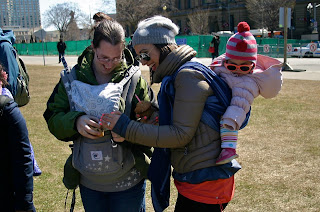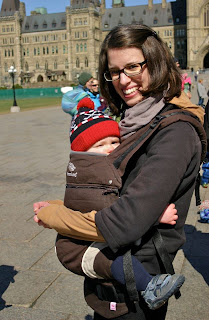By Jessi Mahon Mirault
Photo by Jenna Sparks Bradbury
Welcome to the overwhelming but rewarding world of woven wraps!
Woven
wraps are a similar to stretchy wraps in function, but offer so much
more – specifically, a) support, allowing for longer wearing; b) the
ability to safely wear your littles on your back; and c) a higher weight
maximum, allowing for wearing well into…well, your kid may want out to
go to his/her prom but a woven wrap would still be supporting him/her
until that time!
This doc is meant as a bit of a
generalized primer for those interested in exploring woven wraps, and
represents solely the opinions of its author(s). It can be easy to be
sucked in to wrap collecting and churning, and need to try every
different size, blend, brand, weave, and colour, but this is by no means
inevitable and you’re just as much of a wrapper if you have one
tried-and-true wrap that lasts you all the way through your babywearing
days. Similarly, wraps aren’t for everyone – they’re just one fun
option as we endeavour to find ways to keep our babies close (and our
hands free!).
So, let’s move on to: carries, sizes, blends, and brands.
CARRIES
Here are some of the most popular carries, all of which are fully YouTube-able.
Front
Wrap Cross Carry (FWCC): The first carry many learn, it’s similar to
the Pocket Wrap Cross Carry used in stretchy wraps except that the
horizontal pass is on the inside rather than the outside. It’s a very
comfortable multi-layer front carry, and requires a long (5/6/7) wrap.
Variations include Semi-FWCC (a one-shouldered front or hip carry),
Half-FWCC (a two-shouldered carry tied-at-shoulder), and
Short-FWCC/FWCC-tied-under-bum (a great option when using a shorter
wrap).
Front Cross Carry (FCC): Similar to FWCC but
without the horizontal pass. Some people prefer it, some prefer FWCC.
FCC is cooler for summer, but also doesn’t support babies who tend to
lean back as well as FWCC. It can be done with a slightly shorter wrap
than FWCC, usually a 5/6.
Kangaroo Carry: Kangaroo is a
single-layer front carry with a shoulder flip, often tied-under-bum
(TUB). It can be a difficult carry to learn, but is very comfortable
and cool for summer (fewer layers than FWCC or FCC). It requires a
mid-length (3/4) wrap.
Rucksack Tied in Front Carry: A
Rucksack Tied in Front Carry (or RTIF) is a great first back carry.
It’s single-layered and has cross passes, which go over one leg and
under the other, adding
security and safety. It requires a
mid-length (3/4) wrap. Variations include a Ruck Tied Under Bum (RUB)
and Ruck Ried Tibetan (RTT).
Double Hammock Carry: A
double-hammock (DH) is arguably the most popular back carry, and is the
one where it looks like the mama is wearing a tube top. It’s a
multi-layer carry, and its secret is that the chest pass (the “tube top”
pass) is supposed to support the bulk of the weight so that the
shoulder straps don’t have to. There’s definitely a learning curve to
this carry, but it’s well worth the effort for longer-term wearing. It
requires a bit more length than FWCC, typically a 6/7. Variations
include DH-tied under bum (DH-TUB), DH-tied at shoulder (DH-TAS), DH
tied Tibetan (DH-TT) and DH-rebozo (DH-R).
Rebozo: A
rebozo carry is essentially a ringless ring sling – it’s a
single-layered, one-shouldered hip carry using a short wrap, typically a
size 2, tied with a slipknot. It’s good for quick ups-and-downs or
with a small infant, but can get uncomfortable with a larger wrappee for
any length of time.
SIZES
Wrap companies vary in
how they size their wraps. Most companies use metric sizes indicating
the length of the wrap (e.g., “3.6m”), while others use sizes 1, 2, 3…8.
Here is a breakdown of the most commonly-used sizes, between 2.6m/size
2 and 5.2m/size 7.
2.6m/size 2: Although size 1 wraps do
exist, the smallest size sold by most companies is 2.6m(sometimes 2.7m)
or a size 2. For the majority of people, this wrap can be used for
rebozo and RUB carries, as well as some less-common carries like RRRR.
Petite mamas may be able to do a couple of additional carries with this
size. It is a size mainly used for quick up-and-downs or very small
babies as any carries done with this size lack the necessary support for
longer-term wearing.
3.2m/size 3: This is a somewhat
unpopular size, but mamas who love their size 3s REALLY love them!
Didymos and Oscha (more later) are the main manufacturers that sell size
3 wraps. They offer a bit more versatility than size 2s, but still not
as much as size 4s. Some people can kangaroo carry in them, many can
DH-R or RTIF, but for many it just results in longer tails for rebozo
and RUB carries.
3.6m/size 4: This is a very popular size
for shorter-term wearing, as it is long enough to enable great
versatility while being short enough to not to require multi-layered
carries (which can take more time) and to not have to worry as much
about tails dragging on the ground while
wrapping away from home.
Popular carries with a 4 include RTIF, Kangaroo, FWCC-TUB, Semi-FWCC,
Half-FWCC, DH-TAS, DH-TUB, and many others.
4.2m/size 5:
Size 5 is awkward for some as an in-between size; however, petite mamas
find this to be the perfect size for multi-layer carries, while fluffier
mamas or those with older wrappees find 5s to be a bit more forgiving
when size 4s just don’t offer enough length.
4.6m/size
6: For most average-sized mamas, size 6 is considered “base size”, or
the size needed to comfortably FWCC without excessive tails or tying in
the tapers. Because of this, size 6 is an extremely popular size; it is
often recommended as the best size for people who only want one wrap,
and it is very versatile, allowing such multi-layer carries as FWCC, DH,
DRS2S, BWCC, and others.
5.2m/size 7: Size 7s are long,
but a great option for fluffier mamas, mamas who like long tails or more
room for error, BWing dads, tandem-wearing, and carries requiring a LOT
of fabric like DH-TT. Size 7s are also safer for those not sure of the
size they want, because wraps can always be chopped to suit!
Note
on sizes: Vatanai’s sizes run on the ½ metre, so 2.5m, 3.0m, 3.5m,
4.0m, 4.5m, 5.0m, and 5.5m. They wrap essentially like “short [size]”,
from 2-7. Someone’s always gotta be different!
BLENDS
Cotton:
The vast majority of wraps are cotton – either cotton blended with
another fibre in varying percentages, or 100% cotton. Cotton is easy to
care for and generally soft and comfortable. Other blends are often
more supportive than 100% cotton, and not all 100% cottons are created
equal – some are thicker and blanketier (e.g., Girasols), some are thin,
silky and moldable (e.g., Vatanais), some are silky but not moldable
(e.g., Oschas), some are textured and have a bit of “give” (e.g.,
Uppymamas).
Linen: Linen is very supportive, and is
perhaps the second most-popular fibre after cotton. It is often blended
with linen in varying proportions, and is quite easy to care for –
machine washable with liquid detergents.
Hemp: Hemp is
‘all the rage’ in the wrapping world at the moment, and more
manufacturers are weaving with it. It’s super supportive like linen, as
easy to care for, and becomes “marshmallowy” when broken in (unlike
linen, which becomes silky).
Silk: Silk is an incredibly
strong fibre, and is most often blended with cotton to make wraps. It
requires some special care, but silk lovers are adamant that it is not
as delicate and difficult to care for as common wisdom would suggest.
In the wrapping world there are two main types of silk: mulberry, the
“silky” silk, and tussah, a less-refined, “coarser” silk.
Bamboo:
Bamboo is a soft and silky fibre that is often blended with cotton or
linen. It’s not terrible supportive, but makes a fabulously thin,
delicate wrap. It requires some special care.
Cashmere: I
don’t know a lot about cashmere wraps, as I believe cashmere and babies
should be kept in separate rooms. Some people love their cashmere
wraps, though, and I know that they’re pricey, soft, and require special
care.
Wool: Wool wraps vary greatly depending on the
manufacturer – some are soft with some give (especially if made with
alpaca or merino), while some are thicker and scratchy. All require
special care, and handwashing with wool wash and laying flat to dry is
generally recommended.
BRANDS
Didymos:
celebrating its 40th anniversary this year, Didymos is a pioneer in the
woven-wrap community. Their wraps are incredibly diverse – although one
can describe a Girasol, one must specify a Didymos wrap when interested
in reviews because they’re all so different! Has a number of signature
patterns/weaves, including indios and fish. They use all popular
fibres and make size 3 wraps.
Diva Milano: a relatively new
Italian manufacturer (although their headquarters is currently in
Russia, I believe). Luxurious and expensive. Thus far they primarily
weave with cotton, linen, silk and wool.
Ellevill: a
popular Norwegian wrap company, Ellevill has popularized their Zara and
Jade patterns, as well as their bamboo Paisley collection. They
traditionally wove with 100% cotton and some bamboo blends, but have
recently branched out to include linen and silk, and are releasing a
wool line this winter.
Girasol: Girasols are 100% cotton
and handwoven in Central America. They are reputed to be less
supportive than other wraps, but are also beautiful enough that many
don’t notice or care. There are various exclusives available through
various vendors at various times – it can be very difficult to track
down a particular Girasol.
Heartiness: I don’t know much about Hearti except that they’re luxurious and expensive! Will have to do more research.
KoKaDi:
KoKaDi is known for their whimsical, childlike patterns and colours.
They are a relatively new German business, and many patterns are very
highly sought after. You can purchase both direct from KoKaDi (if any
wraps are in stock!) or from various North American vendors.
Natibaby:
Natibaby is a Polish manufacturer whose wraps are known for being
beautiful and dense. They have had some customer services issues in the
past but apparently are improving. They were the “hot” company when I
started wrapping in summer 2011, but have since passed the torch to
Oscha and Uppymama.
Oscha: Oscha is one of the two “it”
companies right now (the other being Uppymama, although
KoKaDi is also
hot). They’ve been weaving since spring 2011, and have surged in
popularity to the point that it’s nearly impossible to get your hands on
one. They are based in Scotland, and make both 100% Irish linen wraps
as well as jacquards of cotton, linen, and silk blends.
Storchenwiege:
Storchenwiege (“Storch”) is a utilitarian German wrap manufacturer.
They don’t advertise much, they don’t do limited editions or exclusives.
They make the same consistently awesome wraps time and again. So
they’re not terribly exciting for churners or collectors, but they’re
supportive, strong and lovely, and reliable and inexpensive. Their
striped wraps are notoriously tough to break in, and Storch Leos are
among my favourite wraps and the ones I always recommend to new
wrappers.
Uppymama: Uppymama is a Canadian company based
in Red Deer, AB. All wraps are woven by one woman on her farm, and are
predominantly 100% cotton although some merino wool and linen blends
have been woven in the past. Uppymamas are incredibly popular at the
moment, and it’s very difficult to find one so it’s best you not become
enamoured of any Uppys!
Vatanai: Vatanai is, I believe,
based in the Czech Republic (note to self: check this fact!). Their
wraps are 100% cotton, known for being very thin and summer-worthy, and
generally require little breaking in. Vatanai is also the company
through which Pamirs, the handwoven wraps auctioned on eBay a couple of
times a year, are sold.
































